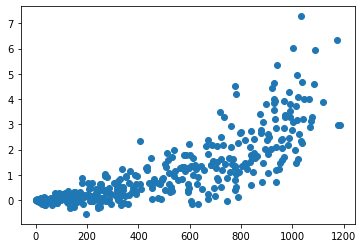

You can also use a color map to assign colors to the markers based on the values of a third variable. We then use the c parameter in the scatter() function to assign the colors to the markers in the plot. In this example, we create a list of colors ( ) that corresponds to each data point in the x and y arrays. # Create the scatter plot with customized colors # Create a list of colors corresponding to each data pointĬolors = In Matplotlib, you can add colors to scatter plots using the c parameter in the scatter() function.
#Simple scatter plot matplotlib how to#
How to Add Colors to Scatter PlotsĪdding colors to a scatter plot can help to highlight patterns or trends in the data, or to differentiate between groups of data points. You can also adjust the marker size to make it larger or smaller depending on your needs. Some common marker styles include circles ( 'o'), squares ( 's'), and triangles ( '^'). You can experiment with different marker styles and sizes to find the ones that work best for your data. We also use the edgecolors and facecolors parameters to customize the edge and face colors of the markers. In this example, we use the marker parameter to set the marker style to a star ( '*') and the s parameter to set the marker size to 100.

Plt.scatter(x, y, marker='*', s=100, edgecolors='black', facecolors='red') # Create the scatter plot with customized marker style and size Here’s an example: import matplotlib.pyplot as plt To customize the marker style and size in a scatter plot, you can use the marker and s parameters in the scatter() function in Matplotlib. How to Customize the Marker Style and Size in Scatter Plot The x-axis will be labeled “X-axis”, the y-axis will be labeled “Y-axis”, and the title of the plot will be “Simple Scatter Plot”. This will create a scatter plot with the data points (1,3), (2,5), (3,4), (4,6), and (5,8) plotted on the x-y plane.
#Simple scatter plot matplotlib full#
Here’s the full code: import matplotlib.pyplot as plt Display the plot using the show() function:.Add axis labels and a title to the plot:.Create the scatter plot using the scatter() function:.Create two arrays with data for the x and y variables:.To create a simple scatter plot in Matplotlib, you can follow these steps: In addition, scatter plots can be used to visualize data in a way that is easy to interpret and communicate to others. Scatter plots can also be used to identify the strength and direction of the relationship between the two variables. They are particularly useful for identifying patterns, trends, and potential outliers in the data. Scatter plots are used to visualize the relationship between two variables. How to Add a Regression Line to Scatter Plots.How to Create Multiple Scatter Plots in the Same Figure.How to Add Labels and Annotations to Scatter Plots.

How to Customize the Marker Style and Size in Scatter Plot.In this tutorial, we will explore how to create and customize scatter plots in Matplotlib. By examining the position of the markers in relation to each other, it is possible to see patterns and relationships between the two variables. In a scatter plot, each data point is represented by a marker on a two-dimensional Cartesian plane, with one variable represented on the x-axis and the other variable represented on the y-axis. Scatter plots are a common type of plot used to display the relationship between two variables. M, c = np.linalg.Matplotlib is a widely-used Python library for creating visualizations, including scatter plots. Y = y.to_numpy() # convert into numpy arraysĪ = np.vstack().T # sent the design matrix using the intercepts X = x.to_numpy() # convert into numpy arrays # given one dimensional x and y vectors - return x and y for fitting a line on top of the regression # optionally you can show the slop and the intercept This is covering the plotly approach #load the libraries Using an example: import numpy as npĮstimate first-degree polynomial: z = np.polyfit(x=df.loc, y=df.loc, deg=1)Īnd plot: ax = df.plot.scatter(x=2005, y=2015)ĭf.trendline.sort_index(ascending=False).plot(ax=ax)Īlso provides the the line equation: 'y='.format(z,z) Estimate a first degree polynomial using the same x values, and add to the ax object created by the. You can use np.polyfit() and np.poly1d().


 0 kommentar(er)
0 kommentar(er)
